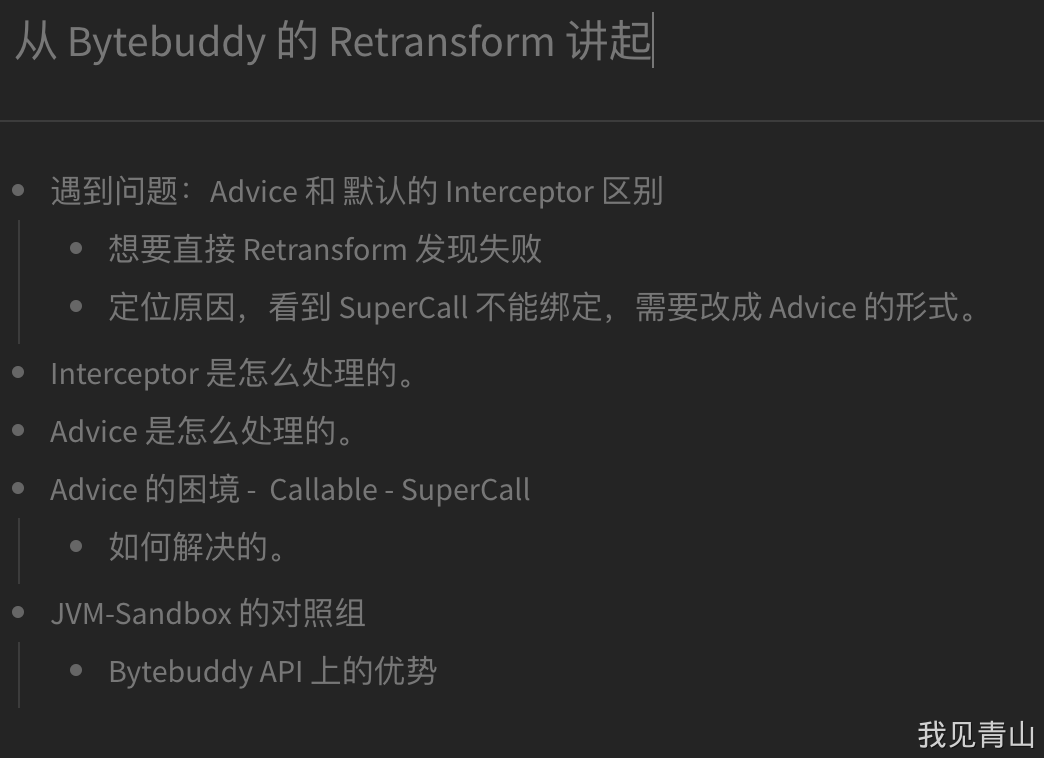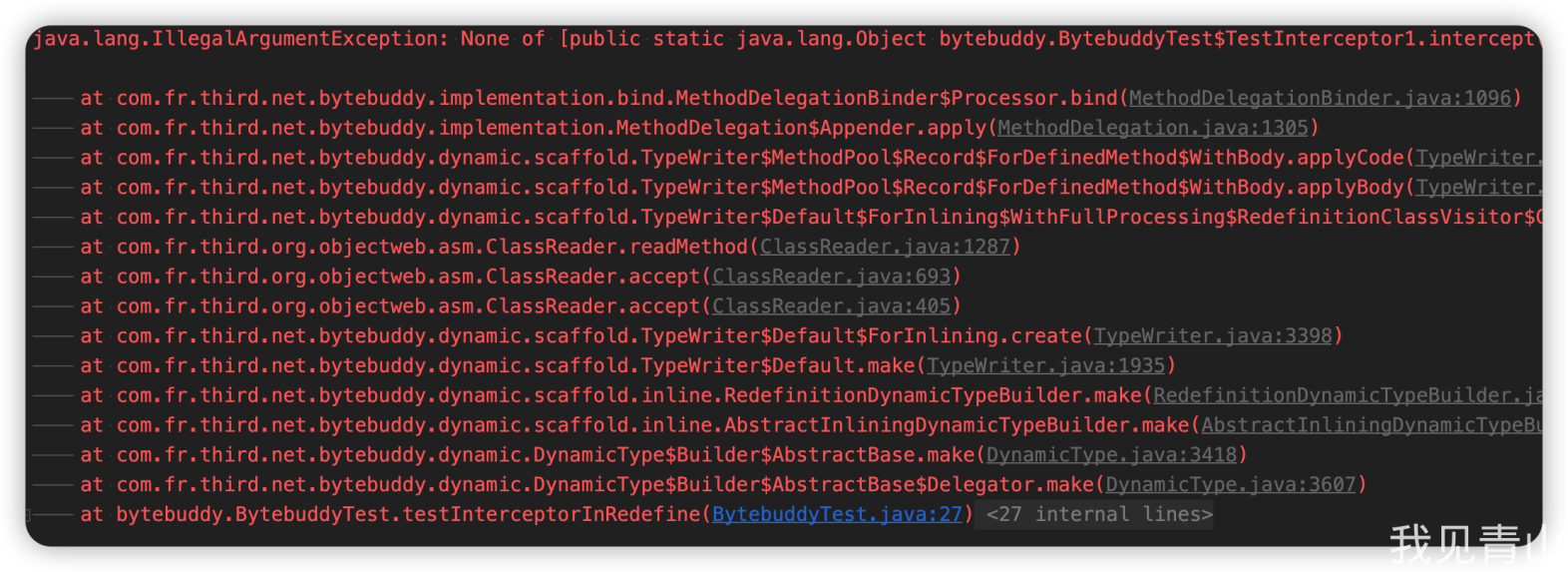从 Bytebuddy 的 Retransform 聊起
前言
本文需要了解 Javaagent,不清楚的朋友可以借阅 参考资料-1 、参考资料-2
简单的讲就是使用 JVM 提供的钩子,无感修改字节码
事件的起因是需要对现在的 Bytebuddy 逻辑修改。
因为 Bytebuddy 好用是好用,但是一旦加载进去,会影响后续所有的 Class 的加载速度。
如果 Class 很多,那么会导致整个流程里面的速度变慢。
所以当时设想的解决方案很简单,业务上能不能滞后启动?原理上能不能滞后启动?
确认业务上没问题后,原理上就是把 premain 改成 agentmain,加载时修改变更为加载后修改。
大纲

修改过程
现有的逻辑
addMutable(AnalyzerKey.KEY, AnalyzerConfiguration.create(new Assistant() {
@Override
public DynamicType.Builder<?> supply(DynamicType.Builder<?> builder, TypeDescription typeDescription, ClassLoader classLoader, JavaModule module) {
return builder
.method(ElementMatchers.isAnnotatedWith(Focus.class))
.intercept(MethodDelegation.to(FocusInterceptor.class));
}
}));
将含有 Focus 注解的方法委派给 FocusInterceptor
@RuntimeType
public static Object intercept(@Origin Method method, @SuperCall Callable<?> callable)
throws Exception {
// 原方法的映射
Object result = callable.call();
if (FocusPolicy.IGNORE == result) {
return result;
}
Focus focus = method.getAnnotation(Focus.class);
String id = FOCUS_POINT_ID_PREFIX + focus.id();
DefaultLimitedMetric.INSTANCE.submit(FocusPoint.create(id, focus.text(), focus.source()), id);
return result;
}然后通过 java agent 的方案将对应的字节码转化后,写入 Classloader 内的。
AgentBuilder.Listener agentListener = getAgentListener();
AgentBuilder builder = middle.with(agentListener);
builder = assemblyBuilder(factory, builder);
builder.installOn(instrumentation);修改逻辑 - 第一版
builder.disableClassFormatChanges()
// 重定义的类型
.with(AgentBuilder.RedefinitionStrategy.RETRANSFORMATION)
// 初始化策略
.with(AgentBuilder.InitializationStrategy.NoOp.INSTANCE)
// 修改类的方式
.with(AgentBuilder.TypeStrategy.Default.REDEFINE)
.installOn(instrumentation)如果要使用 retransform 的方式在类加载之后,再次处理类,通过网上查询的资料发现需要这么写。
然后我就兴致冲冲的写好了,感觉没啥问题啊,很简单。
跑一下试试。一、二、三。

吖,报错了。
没关系,报错是正常的,确认下原因。
/**
* {@inheritDoc}
*/
public MethodBinding bind(Implementation.Target implementationTarget,
MethodDescription source,
TerminationHandler terminationHandler,
MethodInvoker methodInvoker,
Assigner assigner) {
List<MethodBinding> targets = new ArrayList<MethodBinding>();
for (Record record : records) {
MethodBinding methodBinding = record.bind(implementationTarget, source, terminationHandler, methodInvoker, assigner);
if (methodBinding.isValid()) {
targets.add(methodBinding);
}
}
if (targets.isEmpty()) {
throw new IllegalArgumentException("None of " + records + " allows for delegation from " + source);
}
return bindingResolver.resolve(ambiguityResolver, source, targets);
}是这里的参数绑定出问题了。绑定的是哪一个参数呢?
排除法试试。。。发现是 @SuperCall 这个注解的绑定方案。为啥会出问题呢?
查查资料,StackOverFlow、Bytebuddy 官网、源码 Debug 一下。终于发现了问题
定位原因
这边要从 retransform 的方式说起了。
见上文 https://www.yuque.com/3dot141/gpa3qy/yod2il?inner=yb3du 代码块中所讲,支持 Retransform 主要是两部分的设置。
- 重定义类型
_REDEFINITION__ __RETRANSFORMATION_- DISABLED
- 修改类的方式
- REBASE
- REDEFINE
默认直接 installOn 能够支持 SuperCall 的默认配置是
public Default(ByteBuddy byteBuddy) {
this(byteBuddy,
Listener.NoOp.INSTANCE,
DEFAULT_LOCK,
PoolStrategy.Default.FAST,
// REBASE
TypeStrategy.Default.REBASE,
LocationStrategy.ForClassLoader.STRONG,
NativeMethodStrategy.Disabled.INSTANCE,
new InitializationStrategy.SelfInjection.Split(),
// DISABLED
RedefinitionStrategy.DISABLED,
RedefinitionStrategy.DiscoveryStrategy.SinglePass.INSTANCE,
RedefinitionStrategy.BatchAllocator.ForTotal.INSTANCE,
RedefinitionStrategy.Listener.NoOp.INSTANCE,
RedefinitionStrategy.ResubmissionStrategy.Disabled.INSTANCE,
BootstrapInjectionStrategy.Disabled.INSTANCE,
LambdaInstrumentationStrategy.DISABLED,
DescriptionStrategy.Default.HYBRID,
FallbackStrategy.ByThrowableType.ofOptionalTypes(),
ClassFileBufferStrategy.Default.RETAINING,
InstallationListener.NoOp.INSTANCE,
new RawMatcher.Disjunction(
new RawMatcher.ForElementMatchers(ElementMatchers.any(), ElementMatchers.isBootstrapClassLoader().or(ElementMatchers.isExtensionClassLoader())),
new RawMatcher.ForElementMatchers(ElementMatchers.nameStartsWith("com.fr.third.net.bytebuddy.").or(ElementMatchers.nameStartsWith("sun.reflect.")).<TypeDescription>or(ElementMatchers.isSynthetic()))),
Transformation.Ignored.INSTANCE);
}总结一下
| 支持 SuperCall | 不支持 SuperCall |
|---|---|
| 重定义策略 -DISABLED | RETRANSFORMATION |
| 类转化策略 -REBASE | REDEFINE |
这个原因是啥呢?
根据官网的文档所说

redefine 会直接改变对应的类的方法字节码
rebase 会在原来类的基础上,加上辅助类,然后替换原先的字节。
让我们写个 DEMO 确认一下。
@Test
public void testRebase() throws Exception {
DynamicType.Unloaded<TestClass1> unloaded = new ByteBuddy()
.rebase(TestClass1.class)
.method(ElementMatchers.named("testPrint"))
.intercept(MethodDelegation.to(TestInterceptor1.class))
.make();
unloaded.saveIn(new File("/Users/3dot141/Temp/分享文档"));
}
private static class TestInterceptor1 {
@RuntimeType
public static Object intercept(@Origin Method method, @SuperCall Callable<?> callable)
throws Exception {
System.out.println("intercept");
Object result = callable.call();
return result;
}
}
public static class TestClass1 {
public void testPrint() {
}
}如上代码会生成两个类,如下
public static class TestClass1
{
public void testPrint() {
BytebuddyTest$TestInterceptor1.intercept(TestClass1.cachedValue$I5YpbWwx$821p6h2, (Callable)new BytebuddyTest$TestClass1$auxiliary$htJkCEkt(this));
}
static {
TestClass1.cachedValue$I5YpbWwx$821p6h2 = TestClass1.class.getMethod("testPrint", (Class<?>[])new Class[0]);
}
}
class BytebuddyTest$TestClass1$auxiliary$htJkCEkt implements Runnable, Callable
{
private BytebuddyTest.TestClass1 argument0;
@Override
public Object call() throws Exception {
this.argument0.testPrint$original$SYROTrei$accessor$I5YpbWwx();
return null;
}
@Override
public void run() {
this.argument0.testPrint$original$SYROTrei$accessor$I5YpbWwx();
}
BytebuddyTest$TestClass1$auxiliary$htJkCEkt(final BytebuddyTest.TestClass1 argument0) {
this.argument0 = argument0;
}
}TestClass1 的反编译,没有发现 testPrint SYROTrei I5YpbWwx 这个方法。
看一下字节码
// access flags 0x1002
private synthetic testPrint$original$SYROTrei()V
L0
LINENUMBER 59 L0
RETURN
L1
LOCALVARIABLE this Lbytebuddy/BytebuddyTest$TestClass1; L0 L1 0
MAXSTACK = 0
MAXLOCALS = 1
// access flags 0x1010
final synthetic testPrint$original$SYROTrei$accessor$I5YpbWwx()V
ALOAD 0
INVOKESPECIAL bytebuddy/BytebuddyTest$TestClass1.testPrint$original$SYROTrei ()V
RETURN
MAXSTACK = 1
MAXLOCALS = 1发现字节码里面是存在对应的方法的。
结论
所以 Rebase 的方案,就是会生成辅助类、辅助方法,从而能够将对应的类转化为 Callable 直接进行调用。并且保存着原来的方法。和官网说的是一致的。
这样的话生成的辅助类 BytebuddyTest$TestClass1$auxiliary$htJkCEkt 就可以赋值给 SuperCall 绑定的方法,从而让 TestInterceptor 进行调用。
而 Redefine 呢,会直接消除掉辅助的方法从而让 SuperCall 无法绑定,从而出现问题。
本章说
问题一:既然 Rebase 能保留,为啥不能直接用 Rebase,非得用 Redefine
问题二:重定义的区别
修改逻辑 - 第二版
既然 SuperCall 这个注解不能用,那么有没有其他的方案呢?答案是肯定的,那就是 Advice 方案。
相信大家对 Advice 这个概念都不陌生,Spring 生成 Bean 时的 CGLIB 可能是大家第一次接触切面的概念。
Bytebuddy 中同样也存在 Advice 这个概念。计算好一个方法的入口出口,从而修改对应的方法。
参考 Bytebuddy 的源码分析-Advice 篇 的使用逻辑,将 Interceptor 转化成 Advice
public class FocusAdvice implements DesignerAnalyzerAdvice {
private static final String FOCUS_POINT_ID_PREFIX = "function_";
@Advice.OnMethodExit(onThrowable = Exception.class)
public static void onMethodExit(@Advice.Origin Method method,
@Advice.Return(readOnly = false, typing = Assigner.Typing.DYNAMIC) Object result) throws Exception {
if (FocusPolicy.IGNORE == result) {
return;
}
Focus focus = method.getAnnotation(Focus.class);
String id = FOCUS_POINT_ID_PREFIX + focus.id();
DefaultLimitedMetric.INSTANCE.submit(FocusPoint.create(id, focus.text(), focus.source()), id);
}
}
// 使用方式
builder.visit(Advice.to(FocusAdvice.class).on(matcher))改完收工,然后我就一同改啊。将之前的各种 xxInterceptor 改成 xxAdvice。心里美滋滋。小菜一碟,交代码,过 PR。收工。
没有人知道,问题已经悄悄埋下,静静地等着第二天,某一个幸运儿发现它。
问题来自于这样一段转化
public class FaultToleranceInterceptor {
@RuntimeType
public static Object interceptor(@This Object self, @Origin Method method, @SuperCall Callable callable, @AllArguments Object[] args) throws Exception {
FaultTolerance faultTolerance = method.getAnnotation(FaultTolerance.class);
// 交给 FaultTolerance 去执行调用
return FaultToleranceFactory.getInstance().getScene(faultTolerance.scene()).getProcessor().execute(self, callable, args);
}
}
public class FaultToleranceAdvice implements DesignerAnalyzerAdvice {
// 是否忽视当前的方法
@Advice.OnMethodEnter(skipOn = Advice.OnDefaultValue.class)
public static boolean onMethodEnter() throws Exception {
return true;
}
@Advice.OnMethodExit(onThrowable = Exception.class)
public static void onMethodExit(@Advice.This(optional = true, typing = Assigner.Typing.DYNAMIC) Object self,
@Advice.Origin Method method,
@Advice.AllArguments(typing = Assigner.Typing.DYNAMIC) Object[] args,
@Advice.Return(readOnly = false, typing = Assigner.Typing.DYNAMIC) Object result
) throws Exception {
FaultTolerance faultTolerance = method.getAnnotation(FaultTolerance.class);
// 将方法转化成 callable
Callable<Object> callable = () -> method.invoke(self, args);
// 将 callable 传递给 FaultTolerance
// 并修改返回值
result = FaultToleranceFactory.getInstance().getScene(faultTolerance.scene()).getProcessor().execute(self, callable, args);
}
} @Test
public void testCallable() throws Exception {
ByteBuddyAgent.install();
new ByteBuddy()
.redefine(TestClass.class)
.visit(Advice.to(TestCallableAdvice.class).on(ElementMatchers.named("testPrint")))
.make()
.load(TestClass.class.getClassLoader(), ClassReloadingStrategy.fromInstalledAgent());
TestClass testClass = new TestClass();
String print = testClass.testPrint();
Assert.assertEquals("[test]Callable", print);
}
引发报错

定位原因 - 第一次
其实就是访问 lambda 表达式出错了,为什么会出错呢?
这里有几个知识点
- 如果切面不做配置,那么默认是需要内联到原方法体中的。
- 如果不内联,则不能修改返回值。
- 跳过默认的方法体
skipOn - lambda 表达式的访问层级
第四个即是这个问题的重点,让我们看一看这个类的字节码(因为反编译工具是看不出来的==)
public static onMethodExit() {
// 调用 lambda 的方式
INVOKEDYNAMIC call(Ljava/lang/reflect/Method;Ljava/lang/Object;[Ljava/lang/Object;)Ljava/util/concurrent/Callable; [
// handle kind 0x6 : INVOKESTATIC
java/lang/invoke/LambdaMetafactory.metafactory(Ljava/lang/invoke/MethodHandles$Lookup;Ljava/lang/String;Ljava/lang/invoke/MethodType;Ljava/lang/invoke/MethodType;Ljava/lang/invoke/MethodHandle;Ljava/lang/invoke/MethodType;)Ljava/lang/invoke/CallSite;
// arguments:
()Ljava/lang/Object;,
// handle kind 0x6 : INVOKESTATIC
com/fr/design/record/analyzer/TestCallableAdvice.lambda$onMethodExit$0(Ljava/lang/reflect/Method;Ljava/lang/Object;[Ljava/lang/Object;)Ljava/lang/Object;,
()Ljava/lang/Object;
]
}
// access flags 0x100A
private static synthetic lambda$onMethodExit$0(Ljava/lang/reflect/Method;Ljava/lang/Object;[Ljava/lang/Object;)Ljava/lang/Object; throws java/lang/Exception
L0
LINENUMBER 41 L0
ALOAD 0
ALOAD 1
ALOAD 2
INVOKEVIRTUAL java/lang/reflect/Method.invoke (Ljava/lang/Object;[Ljava/lang/Object;)Ljava/lang/Object;
ARETURN
L1
LOCALVARIABLE method Ljava/lang/reflect/Method; L0 L1 0
LOCALVARIABLE self Ljava/lang/Object; L0 L1 1
LOCALVARIABLE args [Ljava/lang/Object; L0 L1 2
MAXSTACK = 3
MAXLOCALS = 3如上,默认的 lambda 表达式的访问层级是 private 的。
当内联到目标方法后,逻辑是这样的
public String testPrint() {
Exception ex = null;
// 首先跳出是用了 label ,这个已经被抛弃的方案。
Label_0035: {
if (!AdviceContext.builder().onAdviceCall().build().isOnAdviceCall()) {
break Label_0035;
}
final TestClass this2 = this;
try {
ex = null;
}
catch (Exception ex) {}
}
final FaultTolerance faultTolerance = TestClass.class.getMethod("testPrint", (Class<?>[])new Class[0]).getAnnotation(FaultTolerance.class);
// 获取生成的 lambda 表达式
Callable var6 = TestCallableAdvice::lambda$onMethodExit$0;
final String s = TestCallableHelper.test(var6);
if (ex != null) {
throw ex;
}
return s;
}所以自然而然就会抛错,修复也很简单,既然 lambda 表达式会抛错,那么直接用非匿名的不就好了。(猜测匿名内部类也是一样。)
所以直接新建一个 AdviceCallable
public class DefaultAdviceCallable<T> implements AdviceCallable<T> {
private final Object self;
private final Method method;
private final Object[] args;
public DefaultAdviceCallable(Object self, @NotNull Method method, Object[] args) {
this.self = self;
this.method = Reflect.accessible(method);
this.args = args;
}
@Override
public T call() throws Exception {
return (T) method.invoke(self, args);
}
}然后再次尝试运行,报错变更

定位原因 - 再一次
问题是啥?为什么会出现这个问题?
总结一下,如何判断当前调用是直接被外部调用,还是经过 Bytebuddy 的 Advice 被调用?
1、通过线程,来获取一个变量,从而知道当前是被谁在调用
需要考虑堆栈的进入、出去。考虑当前线程,子线程。考虑自己调自己
2、能否用一个特征值来告诉当前是从哪里调用的?类似于改变方法体?
重点是运行到自己的时候需要有一个独一无二的值,在 JVM 里面哪些东西符合要求?
本章说
问题一:MethodHandles / invokeDynamic 的引入和原因
问题二:匿名内部类生成后的范围是啥?也是 Private 的吗?
后记
定位问题的时候,源码是要看的,但抛开源码的细节,往上走一层,输入输出往往可以更直观的告诉你问题。
todo:JVM-Sandbox 也是同样的 transform 方案。和 Bytebuddy 有什么异同呢?API 上哪种更好用?设计的更直观?